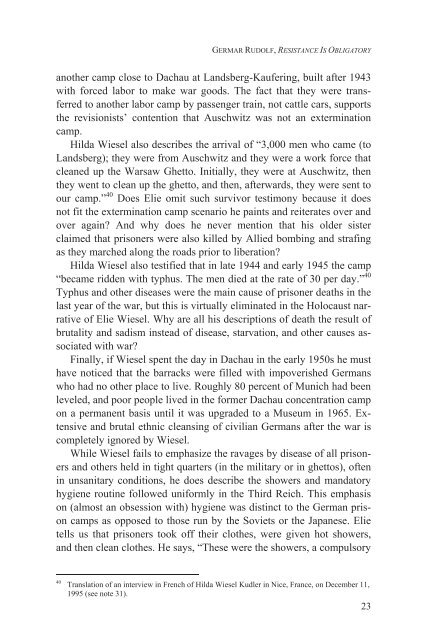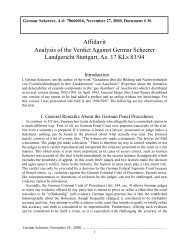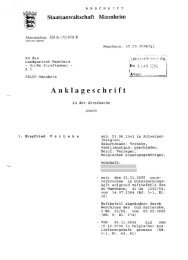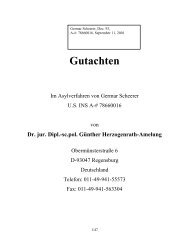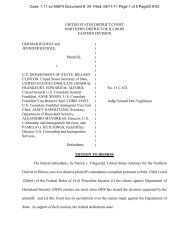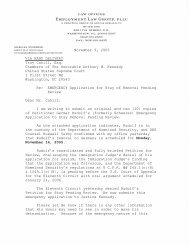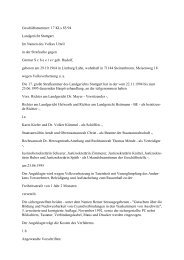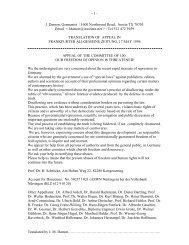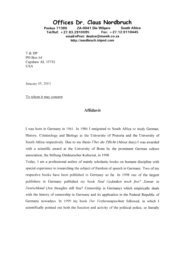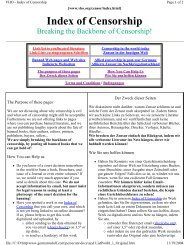- Page 2: GERMAR RUDOLF · RESISTANCE IS OBLI
- Page 5 and 6: Germar Rudolf: Resistance Is Obliga
- Page 7 and 8: GERMAR RUDOLF, RESISTANCE IS OBLIGA
- Page 9 and 10: GERMAR RUDOLF, RESISTANCE IS OBLIGA
- Page 11 and 12: GERMAR RUDOLF, RESISTANCE IS OBLIGA
- Page 13 and 14: GERMAR RUDOLF, RESISTANCE IS OBLIGA
- Page 15 and 16: GERMAR RUDOLF, RESISTANCE IS OBLIGA
- Page 17 and 18: GERMAR RUDOLF, RESISTANCE IS OBLIGA
- Page 19 and 20: GERMAR RUDOLF, RESISTANCE IS OBLIGA
- Page 21 and 22: GERMAR RUDOLF, RESISTANCE IS OBLIGA
- Page 23: GERMAR RUDOLF, RESISTANCE IS OBLIGA
- Page 27 and 28: GERMAR RUDOLF, RESISTANCE IS OBLIGA
- Page 29 and 30: GERMAR RUDOLF, RESISTANCE IS OBLIGA
- Page 32 and 33: A. Introduction GERMAR RUDOLF, RESI
- Page 34 and 35: GERMAR RUDOLF, RESISTANCE IS OBLIGA
- Page 36 and 37: GERMAR RUDOLF, RESISTANCE IS OBLIGA
- Page 38 and 39: GERMAR RUDOLF, RESISTANCE IS OBLIGA
- Page 40 and 41: GERMAR RUDOLF, RESISTANCE IS OBLIGA
- Page 42 and 43: GERMAR RUDOLF, RESISTANCE IS OBLIGA
- Page 44 and 45: GERMAR RUDOLF, RESISTANCE IS OBLIGA
- Page 46 and 47: GERMAR RUDOLF, RESISTANCE IS OBLIGA
- Page 48 and 49: GERMAR RUDOLF, RESISTANCE IS OBLIGA
- Page 50 and 51: GERMAR RUDOLF, RESISTANCE IS OBLIGA
- Page 52 and 53: B. Scientific Considerations I. The
- Page 54 and 55: GERMAR RUDOLF, RESISTANCE IS OBLIGA
- Page 56 and 57: GERMAR RUDOLF, RESISTANCE IS OBLIGA
- Page 58 and 59: GERMAR RUDOLF, RESISTANCE IS OBLIGA
- Page 60 and 61: GERMAR RUDOLF, RESISTANCE IS OBLIGA
- Page 62 and 63: GERMAR RUDOLF, RESISTANCE IS OBLIGA
- Page 64 and 65: GERMAR RUDOLF, RESISTANCE IS OBLIGA
- Page 66 and 67: GERMAR RUDOLF, RESISTANCE IS OBLIGA
- Page 68 and 69: GERMAR RUDOLF, RESISTANCE IS OBLIGA
- Page 70 and 71: GERMAR RUDOLF, RESISTANCE IS OBLIGA
- Page 72 and 73: GERMAR RUDOLF, RESISTANCE IS OBLIGA
- Page 74 and 75:
GERMAR RUDOLF, RESISTANCE IS OBLIGA
- Page 76 and 77:
GERMAR RUDOLF, RESISTANCE IS OBLIGA
- Page 78 and 79:
GERMAR RUDOLF, RESISTANCE IS OBLIGA
- Page 80 and 81:
GERMAR RUDOLF, RESISTANCE IS OBLIGA
- Page 82 and 83:
Arbitrary Selection/Elimination GER
- Page 84 and 85:
GERMAR RUDOLF, RESISTANCE IS OBLIGA
- Page 86 and 87:
GERMAR RUDOLF, RESISTANCE IS OBLIGA
- Page 88 and 89:
GERMAR RUDOLF, RESISTANCE IS OBLIGA
- Page 90 and 91:
GERMAR RUDOLF, RESISTANCE IS OBLIGA
- Page 92 and 93:
GERMAR RUDOLF, RESISTANCE IS OBLIGA
- Page 94 and 95:
GERMAR RUDOLF, RESISTANCE IS OBLIGA
- Page 96 and 97:
GERMAR RUDOLF, RESISTANCE IS OBLIGA
- Page 98:
GERMAR RUDOLF, RESISTANCE IS OBLIGA
- Page 101 and 102:
GERMAR RUDOLF, RESISTANCE IS OBLIGA
- Page 103 and 104:
GERMAR RUDOLF, RESISTANCE IS OBLIGA
- Page 105 and 106:
GERMAR RUDOLF, RESISTANCE IS OBLIGA
- Page 107 and 108:
GERMAR RUDOLF, RESISTANCE IS OBLIGA
- Page 109 and 110:
GERMAR RUDOLF, RESISTANCE IS OBLIGA
- Page 111 and 112:
GERMAR RUDOLF, RESISTANCE IS OBLIGA
- Page 113 and 114:
GERMAR RUDOLF, RESISTANCE IS OBLIGA
- Page 115 and 116:
GERMAR RUDOLF, RESISTANCE IS OBLIGA
- Page 117 and 118:
GERMAR RUDOLF, RESISTANCE IS OBLIGA
- Page 119 and 120:
GERMAR RUDOLF, RESISTANCE IS OBLIGA
- Page 121 and 122:
GERMAR RUDOLF, RESISTANCE IS OBLIGA
- Page 123 and 124:
GERMAR RUDOLF, RESISTANCE IS OBLIGA
- Page 125 and 126:
GERMAR RUDOLF, RESISTANCE IS OBLIGA
- Page 127 and 128:
GERMAR RUDOLF, RESISTANCE IS OBLIGA
- Page 129 and 130:
GERMAR RUDOLF, RESISTANCE IS OBLIGA
- Page 131 and 132:
GERMAR RUDOLF, RESISTANCE IS OBLIGA
- Page 133 and 134:
GERMAR RUDOLF, RESISTANCE IS OBLIGA
- Page 135 and 136:
GERMAR RUDOLF, RESISTANCE IS OBLIGA
- Page 137 and 138:
GERMAR RUDOLF, RESISTANCE IS OBLIGA
- Page 139 and 140:
GERMAR RUDOLF, RESISTANCE IS OBLIGA
- Page 141 and 142:
GERMAR RUDOLF, RESISTANCE IS OBLIGA
- Page 144 and 145:
D. Specific Considerations I. Gener
- Page 146 and 147:
GERMAR RUDOLF, RESISTANCE IS OBLIGA
- Page 148 and 149:
3. Passion GERMAR RUDOLF, RESISTANC
- Page 150 and 151:
GERMAR RUDOLF, RESISTANCE IS OBLIGA
- Page 152 and 153:
GERMAR RUDOLF, RESISTANCE IS OBLIGA
- Page 154 and 155:
GERMAR RUDOLF, RESISTANCE IS OBLIGA
- Page 156 and 157:
GERMAR RUDOLF, RESISTANCE IS OBLIGA
- Page 158 and 159:
GERMAR RUDOLF, RESISTANCE IS OBLIGA
- Page 160 and 161:
GERMAR RUDOLF, RESISTANCE IS OBLIGA
- Page 162 and 163:
GERMAR RUDOLF, RESISTANCE IS OBLIGA
- Page 164 and 165:
GERMAR RUDOLF, RESISTANCE IS OBLIGA
- Page 166 and 167:
GERMAR RUDOLF, RESISTANCE IS OBLIGA
- Page 168 and 169:
GERMAR RUDOLF, RESISTANCE IS OBLIGA
- Page 170 and 171:
GERMAR RUDOLF, RESISTANCE IS OBLIGA
- Page 172 and 173:
GERMAR RUDOLF, RESISTANCE IS OBLIGA
- Page 174 and 175:
7. The Hoax of the Twentieth Centur
- Page 176:
GERMAR RUDOLF, RESISTANCE IS OBLIGA
- Page 179 and 180:
GERMAR RUDOLF, RESISTANCE IS OBLIGA
- Page 181 and 182:
GERMAR RUDOLF, RESISTANCE IS OBLIGA
- Page 183 and 184:
GERMAR RUDOLF, RESISTANCE IS OBLIGA
- Page 185 and 186:
GERMAR RUDOLF, RESISTANCE IS OBLIGA
- Page 187 and 188:
GERMAR RUDOLF, RESISTANCE IS OBLIGA
- Page 189 and 190:
GERMAR RUDOLF, RESISTANCE IS OBLIGA
- Page 191 and 192:
GERMAR RUDOLF, RESISTANCE IS OBLIGA
- Page 193 and 194:
GERMAR RUDOLF, RESISTANCE IS OBLIGA
- Page 195 and 196:
GERMAR RUDOLF, RESISTANCE IS OBLIGA
- Page 197 and 198:
GERMAR RUDOLF, RESISTANCE IS OBLIGA
- Page 199 and 200:
GERMAR RUDOLF, RESISTANCE IS OBLIGA
- Page 201 and 202:
GERMAR RUDOLF, RESISTANCE IS OBLIGA
- Page 203 and 204:
GERMAR RUDOLF, RESISTANCE IS OBLIGA
- Page 205 and 206:
GERMAR RUDOLF, RESISTANCE IS OBLIGA
- Page 207 and 208:
GERMAR RUDOLF, RESISTANCE IS OBLIGA
- Page 210 and 211:
F. Conclusion GERMAR RUDOLF, RESIST
- Page 212 and 213:
GERMAR RUDOLF, RESISTANCE IS OBLIGA
- Page 214 and 215:
GERMAR RUDOLF, RESISTANCE IS OBLIGA
- Page 216 and 217:
GERMAR RUDOLF, RESISTANCE IS OBLIGA
- Page 218 and 219:
GERMAR RUDOLF, RESISTANCE IS OBLIGA
- Page 220 and 221:
G. Path of Most Resistance GERMAR R
- Page 222 and 223:
GERMAR RUDOLF, RESISTANCE IS OBLIGA
- Page 224 and 225:
H. Appendices GERMAR RUDOLF, RESIST
- Page 226 and 227:
GERMAR RUDOLF, RESISTANCE IS OBLIGA
- Page 228 and 229:
GERMAR RUDOLF, RESISTANCE IS OBLIGA
- Page 230 and 231:
GERMAR RUDOLF, RESISTANCE IS OBLIGA
- Page 232 and 233:
GERMAR RUDOLF, RESISTANCE IS OBLIGA
- Page 234 and 235:
GERMAR RUDOLF, RESISTANCE IS OBLIGA
- Page 236 and 237:
GERMAR RUDOLF, RESISTANCE IS OBLIGA
- Page 238 and 239:
GERMAR RUDOLF, RESISTANCE IS OBLIGA
- Page 240 and 241:
Annex 13 GERMAR RUDOLF, RESISTANCE
- Page 242 and 243:
GERMAR RUDOLF, RESISTANCE IS OBLIGA
- Page 244 and 245:
GERMAR RUDOLF, RESISTANCE IS OBLIGA
- Page 246 and 247:
GERMAR RUDOLF, RESISTANCE IS OBLIGA
- Page 248 and 249:
GERMAR RUDOLF, RESISTANCE IS OBLIGA
- Page 250 and 251:
GERMAR RUDOLF, RESISTANCE IS OBLIGA
- Page 252 and 253:
GERMAR RUDOLF, RESISTANCE IS OBLIGA
- Page 254 and 255:
GERMAR RUDOLF, RESISTANCE IS OBLIGA
- Page 256 and 257:
GERMAR RUDOLF, RESISTANCE IS OBLIGA
- Page 258 and 259:
GERMAR RUDOLF, RESISTANCE IS OBLIGA
- Page 260 and 261:
GERMAR RUDOLF, RESISTANCE IS OBLIGA
- Page 262 and 263:
GERMAR RUDOLF, RESISTANCE IS OBLIGA
- Page 264 and 265:
GERMAR RUDOLF, RESISTANCE IS OBLIGA
- Page 266 and 267:
GERMAR RUDOLF, RESISTANCE IS OBLIGA
- Page 268 and 269:
GERMAR RUDOLF, RESISTANCE IS OBLIGA
- Page 270 and 271:
GERMAR RUDOLF, RESISTANCE IS OBLIGA
- Page 272 and 273:
GERMAR RUDOLF, RESISTANCE IS OBLIGA
- Page 274 and 275:
GERMAR RUDOLF, RESISTANCE IS OBLIGA
- Page 276 and 277:
GERMAR RUDOLF, RESISTANCE IS OBLIGA
- Page 278 and 279:
GERMAR RUDOLF, RESISTANCE IS OBLIGA
- Page 280 and 281:
GERMAR RUDOLF, RESISTANCE IS OBLIGA
- Page 282 and 283:
GERMAR RUDOLF, RESISTANCE IS OBLIGA
- Page 284 and 285:
GERMAR RUDOLF, RESISTANCE IS OBLIGA
- Page 286 and 287:
GERMAR RUDOLF, RESISTANCE IS OBLIGA
- Page 288 and 289:
GERMAR RUDOLF, RESISTANCE IS OBLIGA
- Page 290 and 291:
GERMAR RUDOLF, RESISTANCE IS OBLIGA
- Page 292 and 293:
GERMAR RUDOLF, RESISTANCE IS OBLIGA
- Page 294 and 295:
GERMAR RUDOLF, RESISTANCE IS OBLIGA
- Page 296 and 297:
GERMAR RUDOLF, RESISTANCE IS OBLIGA
- Page 298 and 299:
GERMAR RUDOLF, RESISTANCE IS OBLIGA
- Page 300 and 301:
GERMAR RUDOLF, RESISTANCE IS OBLIGA
- Page 302 and 303:
GERMAR RUDOLF, RESISTANCE IS OBLIGA
- Page 304 and 305:
GERMAR RUDOLF, RESISTANCE IS OBLIGA
- Page 306 and 307:
GERMAR RUDOLF, RESISTANCE IS OBLIGA
- Page 308 and 309:
GERMAR RUDOLF, RESISTANCE IS OBLIGA
- Page 310 and 311:
GERMAR RUDOLF, RESISTANCE IS OBLIGA
- Page 312 and 313:
GERMAR RUDOLF, RESISTANCE IS OBLIGA
- Page 314 and 315:
GERMAR RUDOLF, RESISTANCE IS OBLIGA
- Page 316 and 317:
GERMAR RUDOLF, RESISTANCE IS OBLIGA
- Page 318 and 319:
GERMAR RUDOLF, RESISTANCE IS OBLIGA
- Page 320 and 321:
GERMAR RUDOLF, RESISTANCE IS OBLIGA
- Page 322 and 323:
GERMAR RUDOLF, RESISTANCE IS OBLIGA
- Page 324 and 325:
GERMAR RUDOLF, RESISTANCE IS OBLIGA
- Page 326 and 327:
GERMAR RUDOLF, RESISTANCE IS OBLIGA
- Page 328 and 329:
GERMAR RUDOLF, RESISTANCE IS OBLIGA
- Page 330 and 331:
GERMAR RUDOLF, RESISTANCE IS OBLIGA
- Page 332 and 333:
GERMAR RUDOLF, RESISTANCE IS OBLIGA
- Page 334 and 335:
GERMAR RUDOLF, RESISTANCE IS OBLIGA
- Page 336 and 337:
GERMAR RUDOLF, RESISTANCE IS OBLIGA
- Page 338 and 339:
Appendix 6: Book Burning GERMAR RUD
- Page 340 and 341:
Appendix 7: The Verdict I. General
- Page 342 and 343:
GERMAR RUDOLF, RESISTANCE IS OBLIGA
- Page 344 and 345:
GERMAR RUDOLF, RESISTANCE IS OBLIGA
- Page 346 and 347:
GERMAR RUDOLF, RESISTANCE IS OBLIGA
- Page 348 and 349:
GERMAR RUDOLF, RESISTANCE IS OBLIGA
- Page 350 and 351:
GERMAR RUDOLF, RESISTANCE IS OBLIGA
- Page 352 and 353:
GERMAR RUDOLF, RESISTANCE IS OBLIGA
- Page 354 and 355:
GERMAR RUDOLF, RESISTANCE IS OBLIGA
- Page 356 and 357:
GERMAR RUDOLF, RESISTANCE IS OBLIGA
- Page 358 and 359:
GERMAR RUDOLF, RESISTANCE IS OBLIGA
- Page 360 and 361:
GERMAR RUDOLF, RESISTANCE IS OBLIGA
- Page 362 and 363:
Attorneys L. Bock, Liebfrauenstr. 1
- Page 364 and 365:
GERMAR RUDOLF, RESISTANCE IS OBLIGA
- Page 366 and 367:
GERMAR RUDOLF, RESISTANCE IS OBLIGA
- Page 368 and 369:
GERMAR RUDOLF, RESISTANCE IS OBLIGA
- Page 370 and 371:
Dissecting the Holocaust. The Growi
- Page 372 and 373:
Chelmno: A German Camp in History &
- Page 374 and 375:
Special Treatment inAuschwitz: Orig
- Page 376 and 377:
Auschwitz Lies: Legends, Lies and P


